The Role Played by Trust and Its Effect on the Competiveness of Logistics Service Providers in Hungary
Abstract
1. Introduction
2. Literature Review
2.1. The Role of Trust in Establishing Enterprises
2.2. The Role of Trust in the Collaboration OF Enterprises
2.3. The Role of Logistics Providers in the Flexibility of the Supply Chain
2.4. Partner Selection and Its Impact on the Success of Collaboration
2.5. The Factors of Trust Levels in Inter-Organizational Relationships
2.6. Trust-Based Management
2.7. Synthesis and Implications
3. Materials and Methods
3.1. Problem Description
- Hypothesis 1. The trust level of LSP within the enterprise influences the revenue and earnings before tax.
- Hypothesis 2. The internal trust level established by an LSP influences the flexibility of the examined logistics enterprises.
- Hypothesis 3. The trust level of the business environment created by the head manager of logistics enterprises influences the revenue and earnings before tax, as well as the flexibility of the examined enterprises.
3.2. Description of the Questionnaire and the Applied Statistical Methods
4. Results and Discussion
5. Conclusions
Author Contributions
Conflicts of Interest
References
- Knemeyer, A.M.; Corsi, T.M.; Murphy, P.R. Logistics outsourcing relationships: Customer perspectives. J. Bus. Logist. 2003, 24, 77–109. [Google Scholar] [CrossRef]
- Liu, X.; Grant, D.B.; McKinnon, A.C.; Feng, Y. An empirical examination of the contribution of capabilities to the competitiveness of logistics service providers: A perspective from China. Int. J. Phys. Distrib. Logist. Manag. 2010, 40, 847–866. [Google Scholar] [CrossRef]
- Song, Y.Y.; Maher, T.E.; Nicholson, J.D.; Gurney, N.P. Strategic alliances in logistics outsourcing. Asia Pac. J. Mark. Logist. 2000, 12, 3–21. [Google Scholar] [CrossRef]
- Maloni, M.J.; Carter, C.R. Opportunities for research in third-party logistics. Transp. J. 2006, 45, 23–38. [Google Scholar]
- Lukassen, P.J.; Wallenburg, C.M. Pricing third-party logistics services: Integrating insights from the logistics and industrial services literature. Transp. J. 2010, 49, 24–43. [Google Scholar]
- Huemer, L. Unchained from the chain: Supply management from a logistics service provider perspective. J. Bus. Res. 2012, 65, 258–264. [Google Scholar] [CrossRef]
- Ślusarczyk, B. Prospects for the shared services centers development in Poland in the context of human resources availability. Pol. J. Manag. Stud. 2017, 15, 218–231. [Google Scholar] [CrossRef]
- Ellram, L.M. A managerial guideline for the development and implementation of purchasing partnerships. Int. J. Purch. Mater. Manag. 1995, 31, 9–16. [Google Scholar] [CrossRef]
- Karcz, J.; Ślusarczyk, B. Improvements in the Quality of Delivery. Int. J. Qual. Res. 2016, 10, 355–372. [Google Scholar] [CrossRef]
- Lambert, D.M.; Emmelhainz, M.A.; Gardner, J.T. Building successful logistics partnerships. J. Bus. Logist. 1999, 20, 165. [Google Scholar]
- Ganesan, S. Determinants of long-term orientation in buyer-seller relationships. J. Mark. 1994, 58, 1–19. [Google Scholar] [CrossRef]
- Lee, B.C.; Kim, P.S.; Hong, K.S.; Lee, I. Evaluating antecedents and consequences of supply chain activities: An integrative perspective. Int. J. Prod. Res. 2010, 48, 657–682. [Google Scholar] [CrossRef]
- Schoenherr, T.; Narayanan, S.; Narasimhan, R. Trust formation in outsourcing relationships: A social exchange theoretic perspective. Int. J. Prod. Econ. 2015, 169, 401–412. [Google Scholar] [CrossRef]
- Tian, Y.; Lai, F.; Daniel, F. An examination of the nature of trust in logistics outsourcing relationship: Empirical evidence from China. Ind. Manag. Data Syst. 2008, 108, 346–367. [Google Scholar] [CrossRef]
- Dyer, J.H.; Chu, W. The role of trustworthiness in reducing transaction costs and improving performance: Empirical evidence from the United States, Japan, and Korea. Organ. Sci. 2003, 14, 57–68. [Google Scholar] [CrossRef]
- Johnston, D.A.; McCutcheon, D.M.; Stuart, F.I.; Kerwood, H. Effects of supplier trust on performance of cooperative supplier relationships. J. Oper. Manag. 2004, 22, 23–38. [Google Scholar] [CrossRef]
- Kożuch, B.; Jabłoński, A. Trust and Knowledge Sharing. In Intuition, Trust, and Analytics; CRC Press, Taylor & Francis Group: Boca Raton, FL, USA, 2017. [Google Scholar]
- Mayer, R.C.; Davis, J.H.; Schoorman, F.D. An integrative model of organizational trust. Acad. Manag. Rev. 1995, 20, 709–734. [Google Scholar]
- Beth, S.; Burt, D.N.; Copacino, W.; Gopal, C.; Lee, H.L.; Lynch, R.P.; Morris, S. Supply chain challenges. building relationships. Harv. Bus. Rev. 2003, 81, 64–73. [Google Scholar] [PubMed]
- Kelle, P.; Akbulut, A. The role of ERP tools in supply chain information sharing, cooperation, and cost optimization. Int. J. Prod. Econ. 2005, 93, 41–52. [Google Scholar] [CrossRef]
- Capaldo, A.; Giannoccaro, I. Interdependence and network-level trust in supply chain networks: A computational study. Ind. Mark. Manag. 2015, 44, 180–195. [Google Scholar] [CrossRef]
- Franke, U. 4PL-Dienstleister als Innovationscoach in dynamischen Wertschöpfungsnetzwerken. Ind. Manag. 2002, 21, 19–22. [Google Scholar]
- Panayides, P.M.; Lun, Y.V. The impact of trust on innovativeness and supply chain performance. Int. J. Prod. Econ. 2009, 122, 35–46. [Google Scholar] [CrossRef]
- Comer, J.M.; Plank, R.E.; Reid, D.A.; Pullins, E.B. Methods in Sales Research: Perceived Trust in Business-to-Business Sales: A New Measure. J. Pers. Sell. Sales Manag. 1999, 19, 61–71. [Google Scholar] [CrossRef]
- Young-Ybarra, C.; Wiersema, M. Strategic flexibility in information technology alliances: The influence of transaction cost economics and social exchange theory. Organ. Sci. 1999, 10, 439–459. [Google Scholar] [CrossRef]
- Doney, P.M.; Cannon, J.P.; Mullen, M.R. Understanding the influence of national culture on the development of trust. Acad. Manag. Rev. 1998, 23, 601–620. [Google Scholar]
- Kumar, N. The power of trust in manufacturer-retailer relationships. Harv. Bus. Rev. 1996, 74, 92–106. [Google Scholar]
- Das, T.K.; Teng, B.S. Between trust and control: Developing confidence in partner cooperation in alliances. Acad. Manag. Rev. 1998, 23, 491–512. [Google Scholar] [CrossRef]
- Kumar, N.; Scheer, L.K.; Steenkamp, J.-B.E. The effects of perceived interdependence on dealer attitudes. J. Mark. Res. 1995, 32, 348–356. [Google Scholar] [CrossRef]
- Handfield, R.B.; Bechtel, C. The role of trust and relationship structure in improving supply chain responsiveness. Ind. Mark. Manag. 2002, 31, 367–382. [Google Scholar] [CrossRef]
- Kwon, I.W.G.; Suh, T. Trust, commitment and relationships in supply chain management: A path analysis. Supply Chain Manag. Int. J. 2005, 10, 26–33. [Google Scholar] [CrossRef]
- Hofer, A.R.; Knemeyer, A.M.; Dresner, M.E. Antecedents and dimensions of customer partnering behavior in logistics outsourcing relationships. J. Bus. Logist. 2009, 30, 141–159. [Google Scholar] [CrossRef]
- Fukuyama, F. Trust: The Social Virtues and the Creation of Prosperity; Free Press: New York, NY, USA, 1995. [Google Scholar]
- Ha, B.C.; Park, Y.K.; Cho, S. Suppliers’ affective trust and trust in competency in buyers: Its effect on collaboration and logistics efficiency. Int. J. Oper. Prod. Manag. 2011, 31, 56–77. [Google Scholar] [CrossRef]
- Nold, H.A., III. Linking knowledge processes with firm performance: Organizational culture. J. Intellect. Cap. 2012, 13, 16–38. [Google Scholar] [CrossRef]
- Saleh, M.A.; Ali, M.Y.; Mavondo, F.T. Drivers of importer trust and commitment: Evidence from a developing country. J. Bus. Res. 2014, 67, 2523–2530. [Google Scholar] [CrossRef]
- Lopez-de-Silanes, R.; La Porta, R.; Shleifer, A.; Vishny, R. Trust in Large Organizations. Am. Econ. Rev. 1997, 87, 333–338. [Google Scholar]
- Ariely, D. Predictably Irrational—The Hidden Forces That Shape Our Decisions; Harper Collins Publisher: New York, NY, USA, 2008; ISBN 978-0-06-135323-9. [Google Scholar]
- Covey, S.M.; Link, G.; Merrill, R.R. Smart Trust: Creating Prosperity, Energy, and Joy in a Low-Trust World; Simon and Schuster: New York, NY, USA, 2012; ISBN 978-1-4516-5145-4. [Google Scholar]
- Panayides, P.M.; So, M. The impact of integrated logistics relationships on third-party logistics service quality and performance. Marit. Econ. Logist. 2005, 7, 36–55. [Google Scholar] [CrossRef]
- Ellinger, A.E.; Lynch, D.F.; Hansen, J.D. Firm size, web site content, and financial performance in the transportation industry. Ind. Mark. Manag. 2003, 32, 177–185. [Google Scholar] [CrossRef]
- Panayides, P.M. The impact of organizational learning on relationship orientation, logistics service effectiveness and performance. Ind. Mark. Manag. 2007, 36, 68–80. [Google Scholar] [CrossRef]
- Yeung, J.H.Y.; Selen, W.; Zhang, M.; Huo, B. The effects of trust and coercive power on supplier integration. Int. J. Prod. Econ. 2009, 120, 66–78. [Google Scholar] [CrossRef]
- Ganesan, S.; Hess, R. Dimensions and levels of trust: Implications for commitment to a relationship. Mark. Lett. 1997, 8, 439–448. [Google Scholar] [CrossRef]
- Sahay, B.S. Understanding trust in supply chain relationships. Ind. Manag. Data Syst. 2003, 103, 553–563. [Google Scholar] [CrossRef]
- Barratt, M. Understanding the meaning of collaboration in the supply chain. Supply Chain Manag. Int. J. 2004, 9, 30–42. [Google Scholar] [CrossRef]
- Nadarajah, G.S. Factors Influencing Third Party Logistics Performance in Malaysia: The Role of Trust as a Mediator. Int. J. Supply Chain Manag. 2015, 4, 108–114. [Google Scholar]
- Chapman, R.L.; Soosay, C.; Kandampully, J. Innovation in logistic services and the new business model: A conceptual framework. Int. J. Phys. Distrib. Logist. Manag. 2003, 33, 630–650. [Google Scholar] [CrossRef]
- Fawcett, S.E.; Jones, S.L.; Fawcett, A.M. Supply chain trust: The catalyst for collaborative innovation. Bus. Horiz. 2012, 55, 163–178. [Google Scholar] [CrossRef]
- Hong, P.; Dobrzykowski, D.; Won Park, Y.; Liao, K.; Sharkey, T.W.; Ragu-Nathan, T.; Vonderembse, M. Trust-driven joint operational activities to achieve mass customization: A culture perspective. Benchmarking 2012, 19, 585–603. [Google Scholar] [CrossRef]
- Lee, H.L.; Billington, C. The evolution of supply-chain-management models and practice at Hewlett-Packard. Interfaces 1995, 25, 42–63. [Google Scholar] [CrossRef]
- Stank, T.P.; Keller, S.B.; Daugherty, P.J. Supply chain collaboration and logistical service performance. J. Bus. Logist. 2001, 22, 29–48. [Google Scholar] [CrossRef]
- Kersten, W.; Koch, J.; Hohrath, P.; Voss, C.; Verma, R. Motivation for the outsourcing of complex logistics services. In Proceedings of the POMS College of Service Operations and EurOMA Conference—New Challenges in Service Operations, London, UK, 12–13 July 2007. [Google Scholar]
- Daudi, M.; Hauge, J.B.; Thoben, K.-D. Influence of Information Sharing Behavior on Trust in Collaborative Logistics. In Proceedings of the Working Conference on Virtual Enterprises, Vicenza, Italy, 18–20 September 2017; Springer International Publishing AG: Cham, Switzerland, 2017; pp. 493–506. [Google Scholar]
- Sinkovics, R.R.; Roath, A.S. Strategic orientation, capabilities, and performance in manufacturer-3PL relationships. J. Bus. Logist. 2004, 25, 43–64. [Google Scholar] [CrossRef]
- Evans, J.S. Strategic flexibility for high technology manoeuvres: A conceptual framework. J. Manag. Stud. 1991, 28, 69–89. [Google Scholar] [CrossRef]
- Golden, W.; Powell, P. Towards a definition of flexibility: In search of the Holy Grail? Omega 2000, 28, 373–384. [Google Scholar] [CrossRef]
- De Haan, J.; Kwakkel, J.; Walker, W.; Spirco, J.; Thissen, W. Framing flexibility: Theorising and data mining to develop a useful definition of flexibility and related concepts. Futures 2011, 43, 923–933. [Google Scholar] [CrossRef]
- Moon, K.K.L.; Yi, C.Y.; Ngai, E. An instrument for measuring supply chain flexibility for the textile and clothing companies. Eur. J. Oper. Res. 2012, 222, 191–203. [Google Scholar] [CrossRef]
- Daudi, M.; Hauge, J.B.; Thoben, K.-D. Behavioral factors influencing partner trust in logistics collaboration: A review. Logist. Res. 2016, 9, 1–19. [Google Scholar] [CrossRef]
- Tsamenyi, M.; Cullen, J.; Moeller, K. Partner selection, partner behavior, and business network performance: An empirical study on German business networks. J. Account. Organ. Chang. 2010, 6, 27–51. [Google Scholar] [CrossRef]
- Skopik, F.; Schall, D.; Dustdar, S. Modeling and mining of dynamic trust in complex service-oriented systems. Inf. Syst. 2010, 35, 735–757. [Google Scholar] [CrossRef]
- Day, M.; Fawcett, S.E.; Fawcett, A.M.; Magnan, G.M. Trust and relational embeddedness: Exploring a paradox of trust pattern development in key supplier relationships. Ind. Mark. Manag. 2013, 42, 152–165. [Google Scholar] [CrossRef]
- Williamson, O.E. Comparative economic organization: The analysis of discrete structural alternatives. Adm. Sci. Q. 1991, 36, 269–296. [Google Scholar] [CrossRef]
- Handfield, R.B. A resource dependence perspective of just-in-time purchasing. J. Oper. Manag. 1993, 11, 289–311. [Google Scholar] [CrossRef]
- Doney, P.M.; Cannon, J.P. An examination of the nature of trust in buyer-seller relationships. J. Mark. 1997, 61, 35–51. [Google Scholar] [CrossRef]
- Dwyer, F.R.; Schurr, P.H.; Oh, S. Developing buyer-seller relationships. J. Mark. 1987, 51, 11–27. [Google Scholar] [CrossRef]
- Geyskens, I.; Steenkamp, J.-B.E.; Scheer, L.K.; Kumar, N. The effects of trust and interdependence on relationship commitment: A trans-Atlantic study. Int. J. Res. Mark. 1996, 13, 303–317. [Google Scholar] [CrossRef]
- Johnson, J.L. Strategic integration in industrial distribution channels: Managing the interfirm relationship as a strategic asset. J. Acad. Mark. Sci. 1999, 27, 4–18. [Google Scholar] [CrossRef]
- Dyer, J.H.; Singh, H. The relational view: Cooperative strategy and sources of interorganizational competitive advantage. Acad. Manag. Rev. 1998, 23, 660–679. [Google Scholar] [CrossRef]
- Monczka, R.M.; Petersen, K.J.; Handfield, R.B.; Ragatz, G.L. Success factors in strategic supplier alliances: The buying company perspective. Decis. Sci. 1998, 29, 553–577. [Google Scholar] [CrossRef]
- Spekman, R.; Isabella, L.; MacAvoy, T. Alliance Competence: Maximizing the Value of Your Partnerships; John Wiley& Sons: New York, NY, USA, 2000; ISBN 978-0-471-33063-9. [Google Scholar]
- Sherman, S. Are Strategic Alliances Working? Fortune 1992, 126, 77–78. [Google Scholar]
- Ring, P.S.; Van de Ven, A.H. Developmental processes of cooperative interorganizational relationships. Acad. Manag. Rev. 1994, 19, 90–118. [Google Scholar] [CrossRef]
- Juga, J.; Juntunen, J. Trust, control and confidence in logistics outsourcing decisions. Int. J. Serv. Technol. Manag. 2011, 15, 178–191. [Google Scholar] [CrossRef]
- Pomponi, F.; Fratocchi, L.; Rossi Tafuri, S. Trust development and horizontal collaboration in logistics: A theory based evolutionary framework. Supply Chain Manag. 2015, 20, 83–97. [Google Scholar] [CrossRef]
- Zaheer, A.; McEvily, B.; Perrone, V. Does trust matter? Exploring the effects of interorganizational and interpersonal trust on performance. Organ. Sci. 1998, 9, 141–159. [Google Scholar] [CrossRef]
- Lawson, B.; Tyler, B.B.; Cousins, P.D. Antecedents and consequences of social capital on buyer performance improvement. J. Oper. Manag. 2008, 26, 446–460. [Google Scholar] [CrossRef]
- Blomqvist, K. The many faces of trust. Scand. J. Manag. 1997, 13, 271–286. [Google Scholar] [CrossRef]
- Gambetta, D. Can we trust trust. In Trust: Making and Breaking Cooperative Relations; University of Oxford: Oxford, UK, 2000; pp. 213–237. [Google Scholar]
- Schumacher, C.R. Trust-a source of success in strategic alliances? Schmalenbach Bus. Rev. 2006, 58, 259–278. [Google Scholar] [CrossRef]
- Nyaga, G.N.; Whipple, J.M.; Lynch, D.F. Examining supply chain relationships: Do buyer and supplier perspectives on collaborative relationships differ? J. Oper. Manag. 2010, 28, 101–114. [Google Scholar] [CrossRef]
- Morgan, R.M.; Hunt, S.D. The commitment-trust theory of relationship marketing. J. Mark. 1994, 58, 20–38. [Google Scholar] [CrossRef]
- Hurley, R.F. The decision to trust. Harv. Bus. Rev. 2006, 84, 55–62. [Google Scholar] [PubMed]
- Brodbeck, F.C.; Frese, M.; Akerblom, S.; Audia, G.; Bakacsi, G.; Bendova, H.; Bodega, D.; Bodur, M.; Booth, S.; Brenk, K. Cultural variation of leadership prototypes across 22 European countries. J. Occup. Organ. Psychol. 2000, 73, 1–29. [Google Scholar] [CrossRef]
- Bass, B.M.; Stogdill, R.M. Bass and Stogdill’s Handbook of Leadership: Theory, Research, and Managerial Applications; Simon and Schuster Inc.: New York, NY, USA, 1990; ISBN 0-02-901500-6. [Google Scholar]
- Fiedler, F.E.; Garcia, J.E. New Approaches to Effective Leadership: Cognitive Resources and Organizational Performance; John Wiley & Sons: New York, NY, USA, 1987; ISBN 978-047-1874560. [Google Scholar]
- Dirks, K.T.; Ferrin, D.L. The role of trust in organizational settings. Organ. Sci. 2001, 12, 450–467. [Google Scholar] [CrossRef]
- Dirks, K.T.; Ferrin, D.L. Trust in leadership: Meta-analytic findings and implications for research and practice. J. Appl. Psychol. 2002, 87, 611. [Google Scholar] [CrossRef] [PubMed]
- McEvily, B.; Tortoriello, M. Measuring trust in organisational research: Review and recommendations. J. Trust Res. 2011, 1, 23–63. [Google Scholar] [CrossRef]
- Cai, S.; Goh, M.; de Souza, R.; Li, G. Knowledge sharing in collaborative supply chains: Twin effects of trust and power. Int. J. Prod. Res. 2013, 51, 2060–2076. [Google Scholar] [CrossRef]
- Roehrich, J.K.; Lewis, M.A.; George, G. Are public–private partnerships a healthy option? A systematic literature review. Soc. Sci. Med. 2014, 113, 110–119. [Google Scholar] [CrossRef] [PubMed]
- Koltai, Z. A magyarországi városok versenyképességének vállalati megítélése. Tér és Társadalom 2007, 21, 23–42. [Google Scholar]
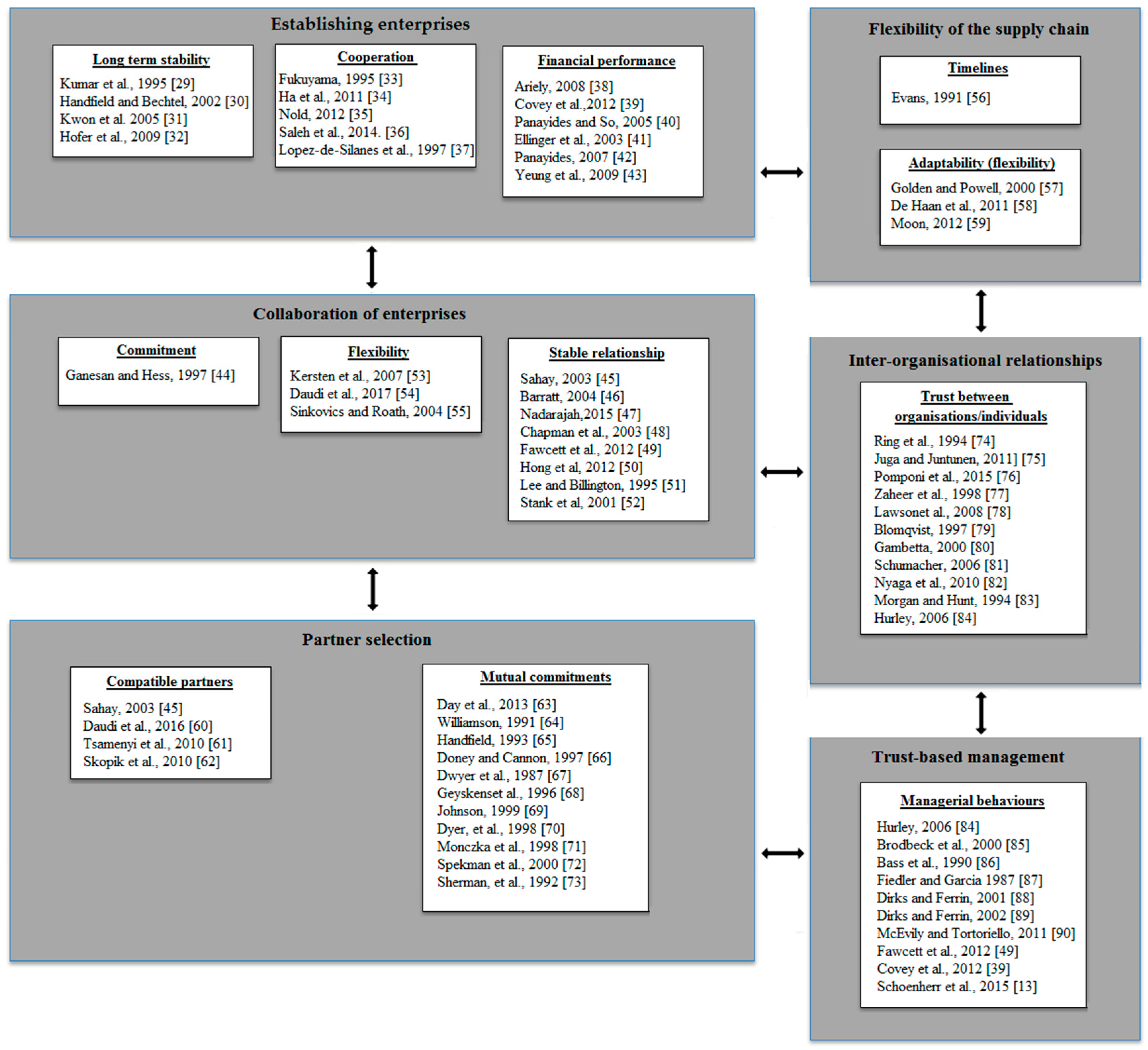
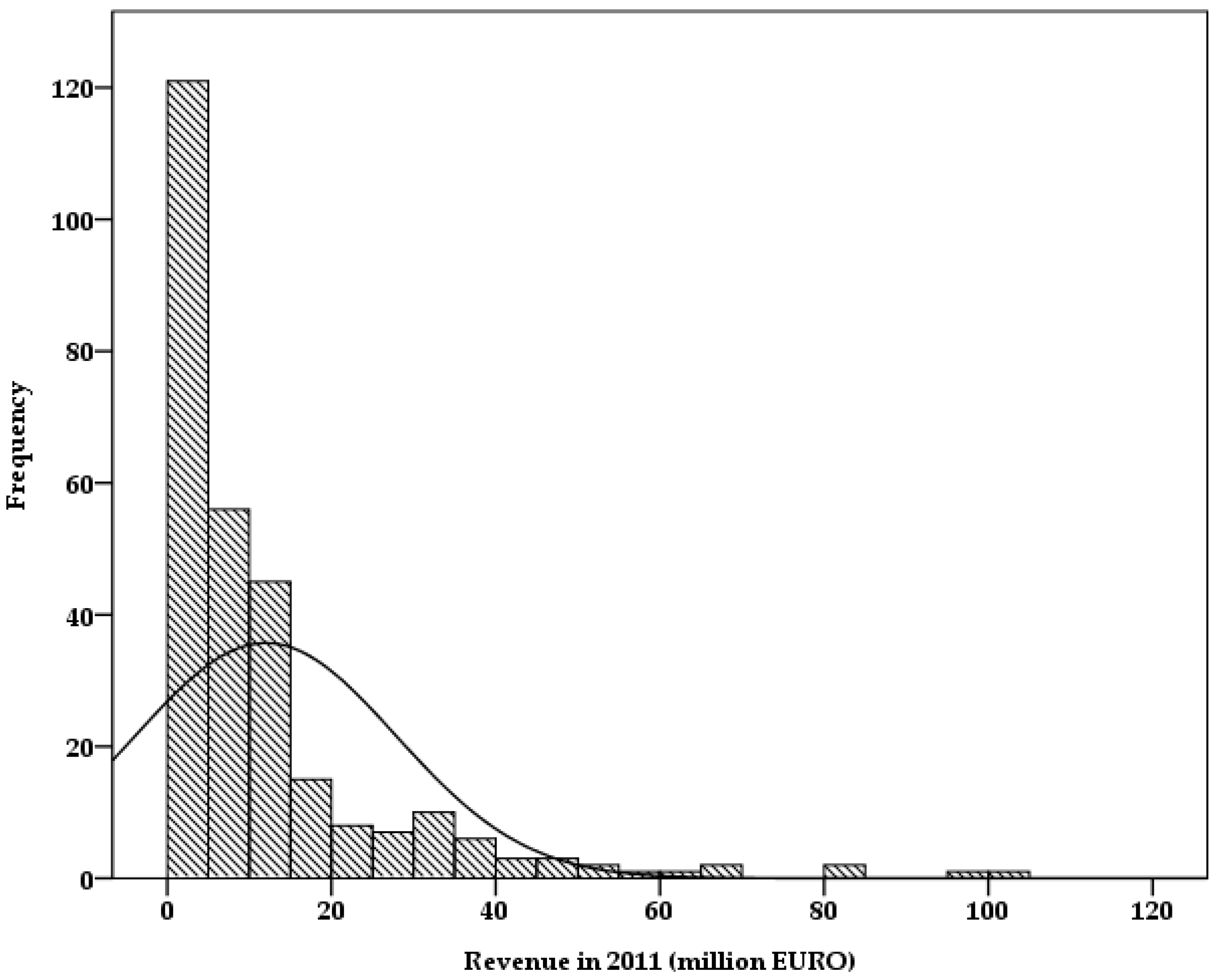
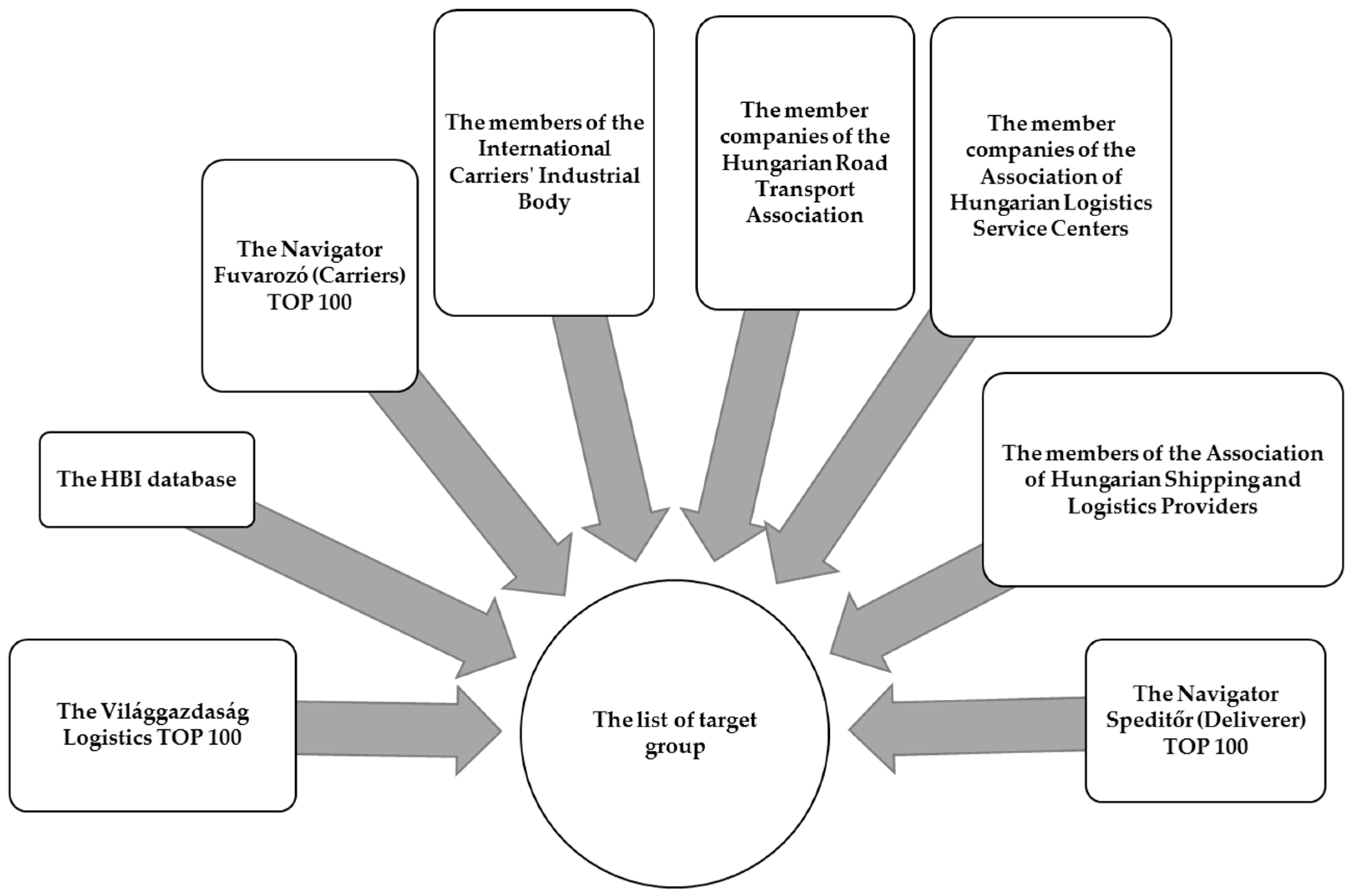
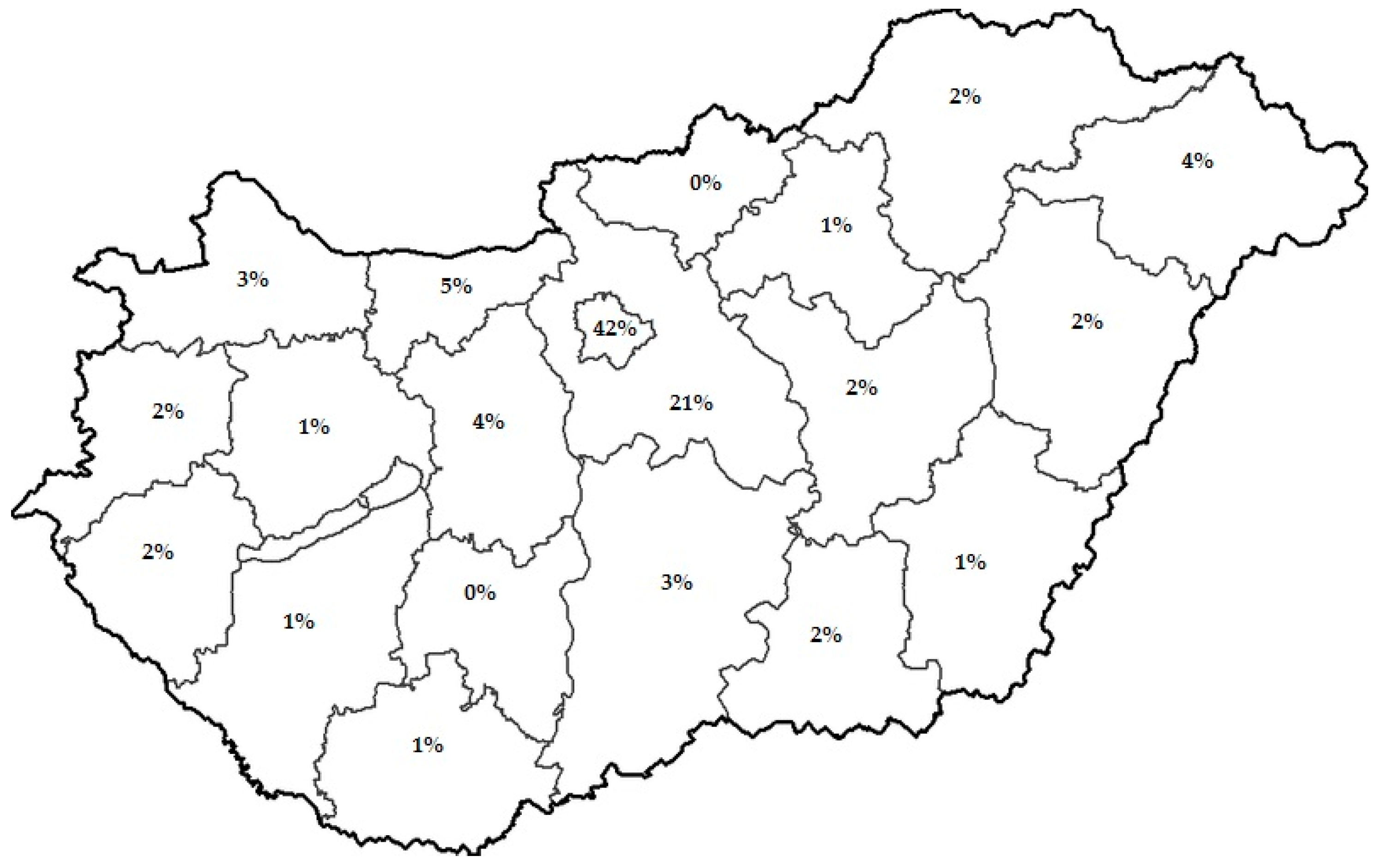
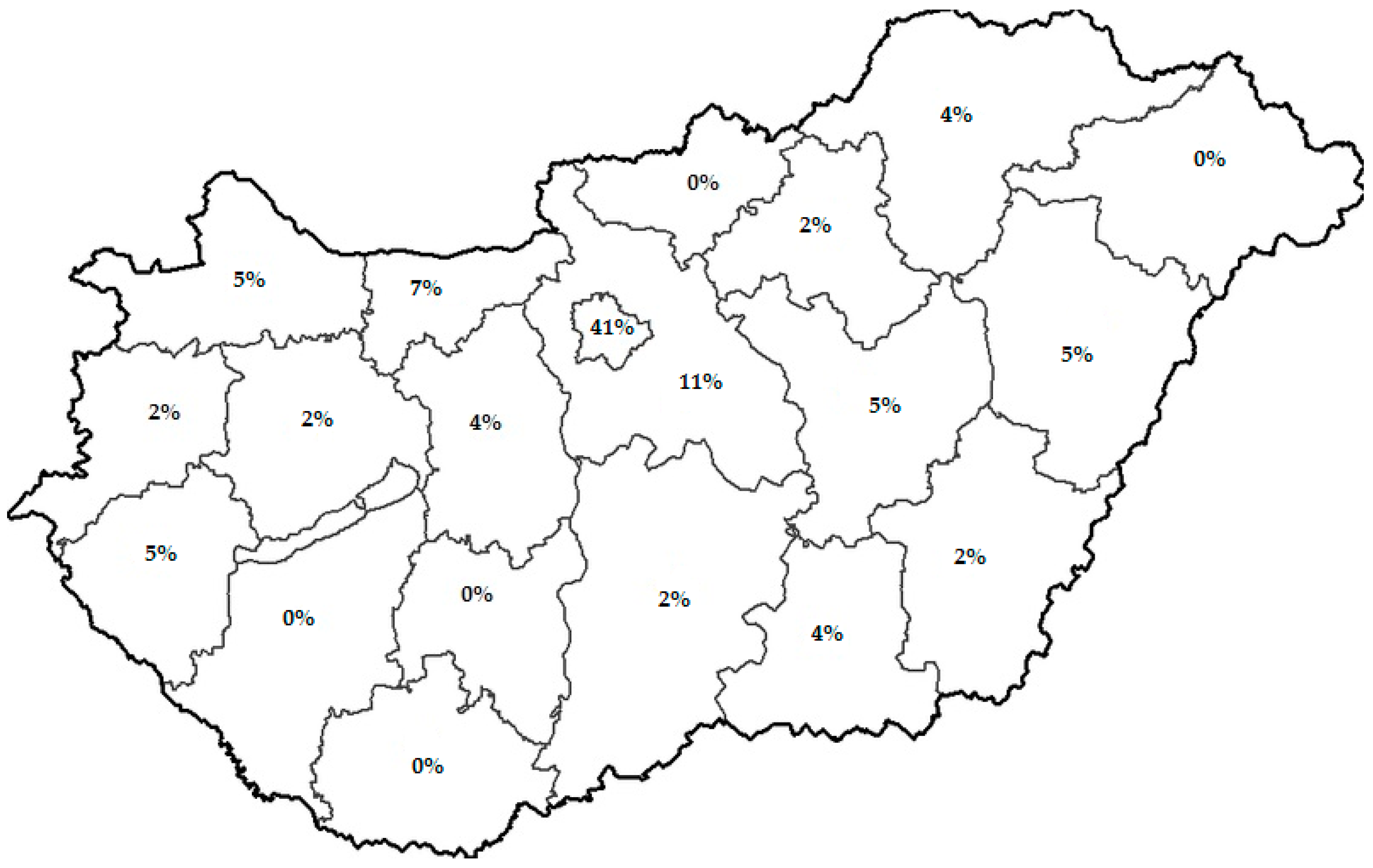
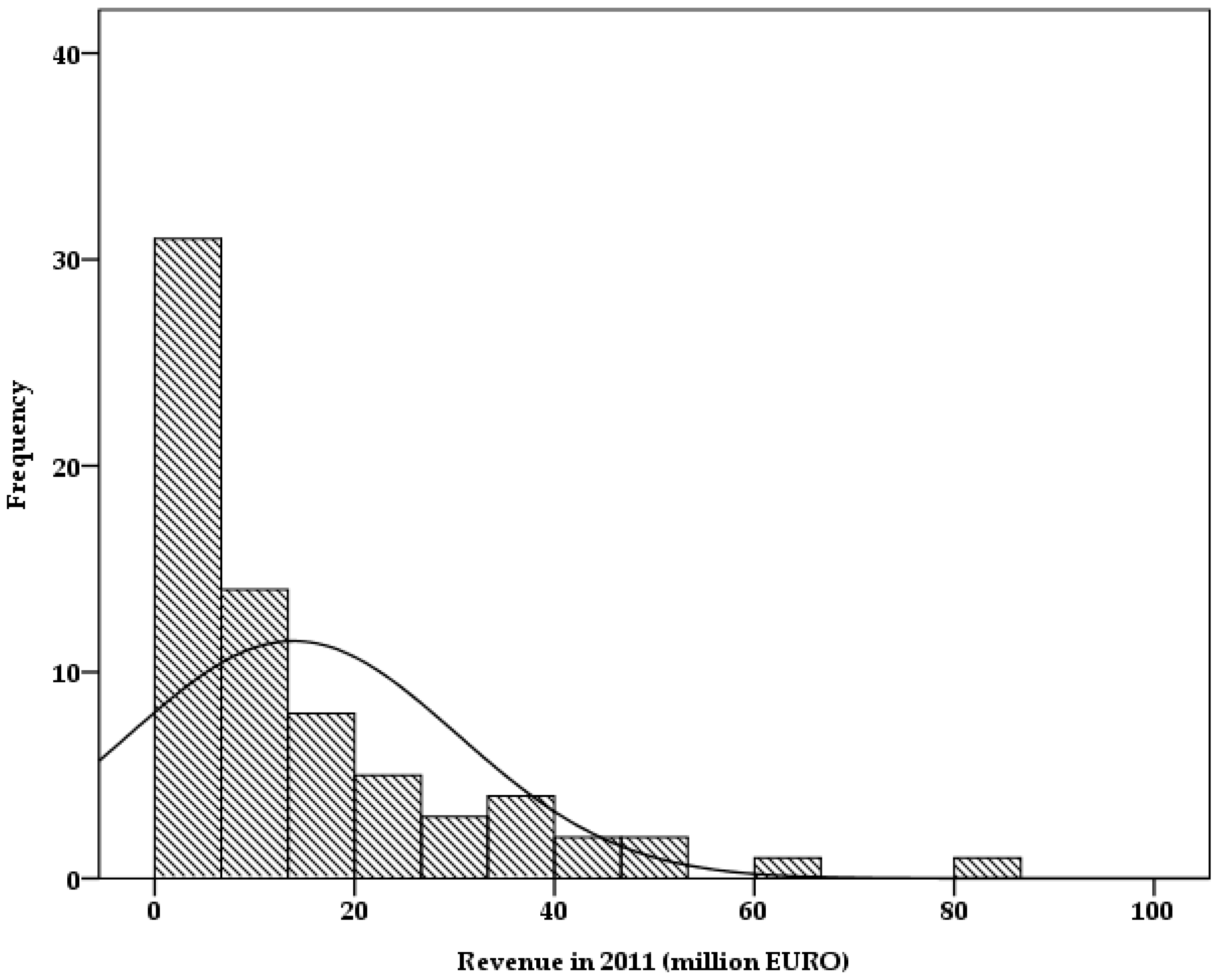
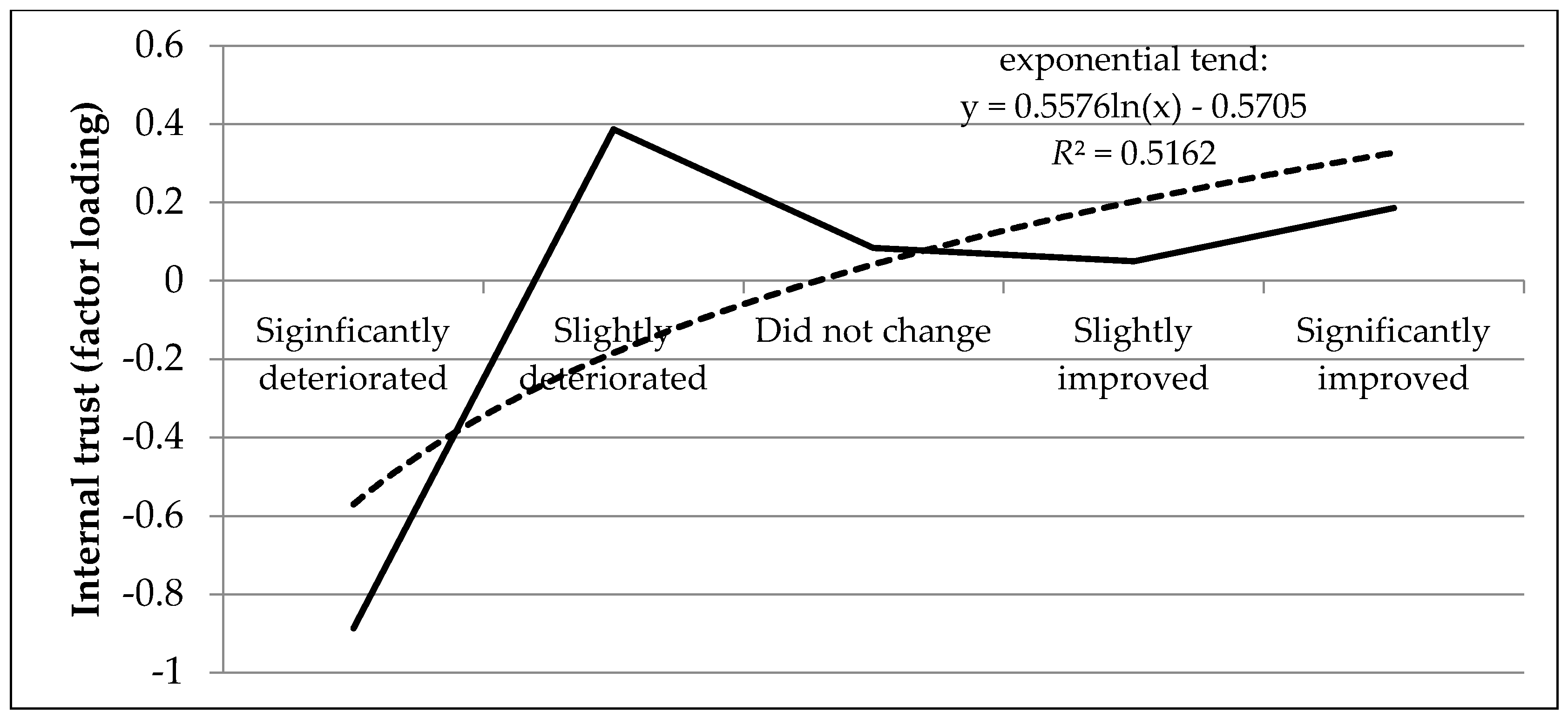
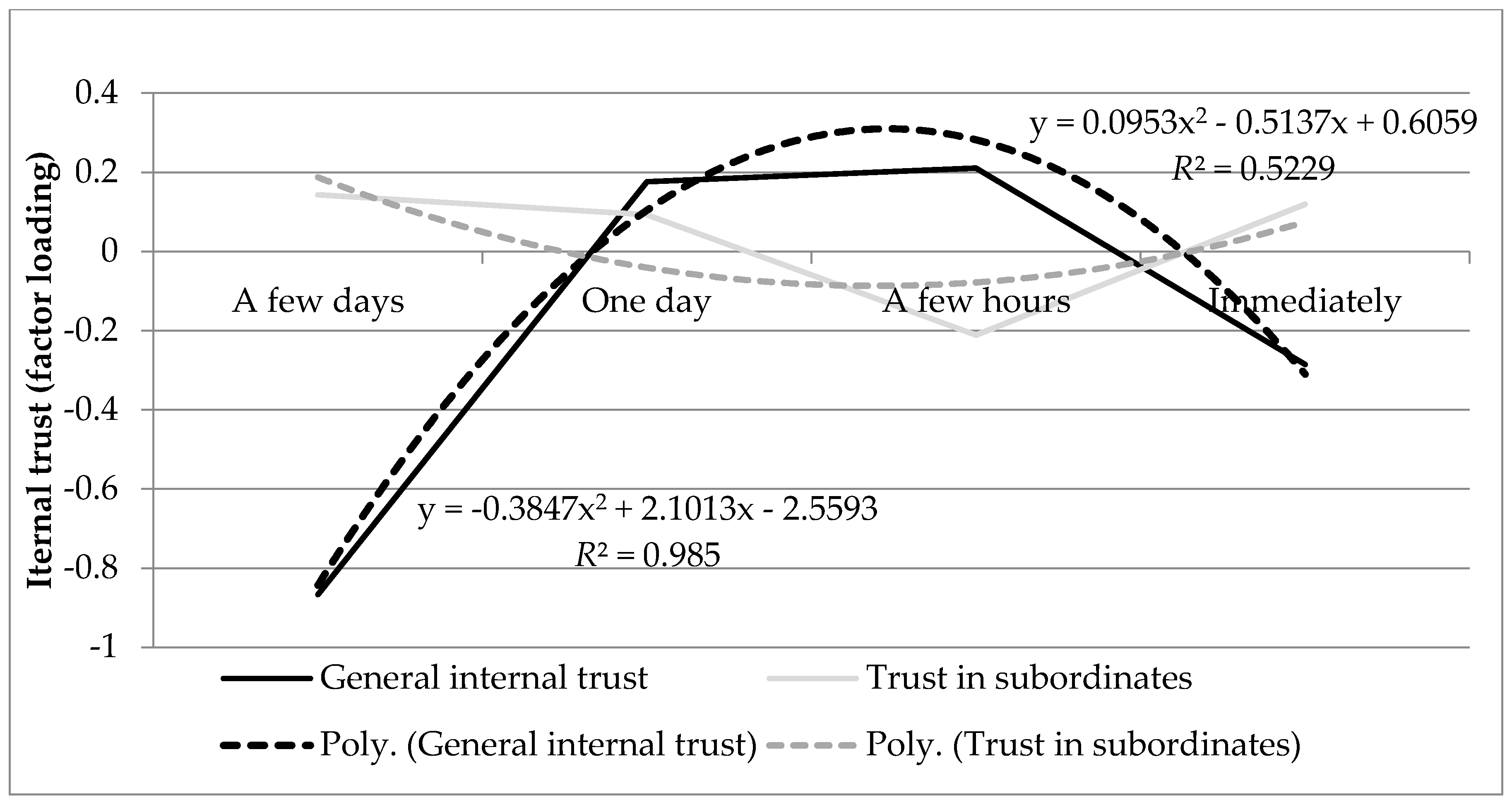
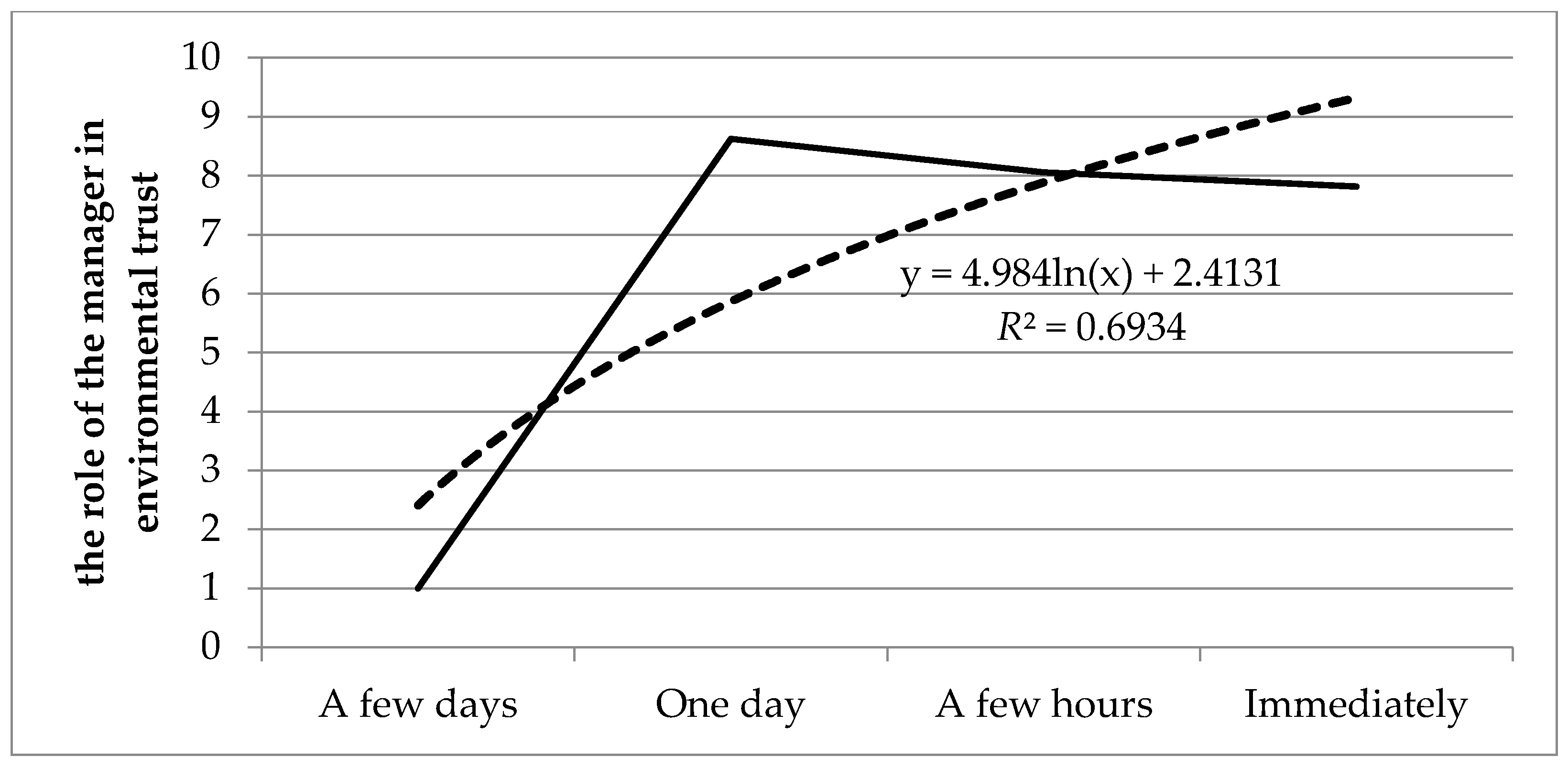
| F1: General Internal Trust | F2: Trust in Subordinates |
|---|---|
| B12: judgement of general trust | B13_1: trust in direct subordinates |
| B13_2: trust in the rest of co-workers | B13_3: trust of direct subordinates in the manager |
| B13_4: trust of direct subordinates in the rest of co-workers |
| Homogeneity Analysis of F1 and F2 in A4 | ||||
| Levene’s test | df1 | df2 | Significance | |
| F1: general internal trust | 1.581 | 6 | 49 | 0.173 |
| F2: trust in subordinates | 2.079 | 6 | 49 | 0.073 |
| Homogeneity Analysis of F1 and F2 in A5 | ||||
| Levene’s test | df1 | df2 | Significance | |
| F1: general internal trust | 2.281 | 4 | 51 | 0.073 |
| F2: trust in subordinates | 4.350 | 4 | 51 | 0.004 |
| Homogeneity Analysis of the Variance of Factors F1 and F2 | ||||
|---|---|---|---|---|
| Levene’s test | df1 | df2 | Significance | |
| F1: general internal trust | 4.699 | 3 | 52 | 0.006 |
| F2: trust in subordinates | 0.938 | 3 | 52 | 0.429 |
| B14 (Managerial Role) | B15 (Managerial Style) | ||
|---|---|---|---|
| A4 (change of revenue) | Phi significance | 0.450 | 0.920 |
| Cramer’s V significance | 0.450 | 0.920 | |
| A5 (change of earnings before tax) | Phi significance | 0.342 | 0.742 |
| Cramer’s V significance | 0.342 | 0.742 |
| Value | Estimated Significance | ||
|---|---|---|---|
| Closeness of association correlation | Phi | 0.847 | 0.048 |
| Cramer’s V | 0.489 | 0.048 | |
| Number of cases to be analyzed | 51 | ||
| Value | Estimated Significance | ||
|---|---|---|---|
| Closeness of association correlation | Phi | 0.584 | 0.496 |
| Cramer’s V | 0.337 | 0.496 | |
| Number of cases to be analyzed | 51 | ||
© 2017 by the authors. Licensee MDPI, Basel, Switzerland. This article is an open access article distributed under the terms and conditions of the Creative Commons Attribution (CC BY) license (http://creativecommons.org/licenses/by/4.0/).
Share and Cite
Oláh, J.; Bai, A.; Karmazin, G.; Balogh, P.; Popp, J. The Role Played by Trust and Its Effect on the Competiveness of Logistics Service Providers in Hungary. Sustainability 2017, 9, 2303. https://doi.org/10.3390/su9122303
Oláh J, Bai A, Karmazin G, Balogh P, Popp J. The Role Played by Trust and Its Effect on the Competiveness of Logistics Service Providers in Hungary. Sustainability. 2017; 9(12):2303. https://doi.org/10.3390/su9122303
Chicago/Turabian StyleOláh, Judit, Attila Bai, György Karmazin, Péter Balogh, and József Popp. 2017. "The Role Played by Trust and Its Effect on the Competiveness of Logistics Service Providers in Hungary" Sustainability 9, no. 12: 2303. https://doi.org/10.3390/su9122303
APA StyleOláh, J., Bai, A., Karmazin, G., Balogh, P., & Popp, J. (2017). The Role Played by Trust and Its Effect on the Competiveness of Logistics Service Providers in Hungary. Sustainability, 9(12), 2303. https://doi.org/10.3390/su9122303








